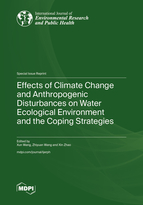Effects of Climate Change and Anthropogenic Disturbances on Water Ecological Environment and the Coping Strategies
A special issue of International Journal of Environmental Research and Public Health (ISSN 1660-4601). This special issue belongs to the section "Environmental Ecology".
Deadline for manuscript submissions: closed (6 April 2023) | Viewed by 18762
Special Issue Editors
Interests: biogeochemical cycling; microbial ecology; river damming; watershed management
Special Issues, Collections and Topics in MDPI journals
2. Yangtze Institute for Conservation and Green Development, Nanjing 210098, China
3. Center for Eco-Environment Research, Nanjing Hydraulic Research Institute, Nanjing 210098, China
Interests: ecotoxicology; emerging micropollutants; eutrophication and harmful algal bloom; water environmental health
Interests: wastes anaerobic fermentation; bioenergy recovery, biological processes; wastes conversion and biological treatment; wastewater treatment
Special Issues, Collections and Topics in MDPI journals
Special Issue Information
Dear Colleagues,
Recognition of global climate change as an environmental issue has drawn attention to the climatic impact of human activities. Paleoclimate records from tree rings, coral, and ice cores indicate a clear warming trend spanning the entire 20th century and the first decade of the 21st century. In fact, the 20th century was the warmest of the past 10 centuries, and the decade 2011–2020 was the warmest decade since the beginning of modern record. Scientists and environmentalists have pointed out that human-induced climate change results from the disturbance in all aspects of the environment.
Among them, aquatic environments (including water, sediments, aquatic organisms, et al.) are closely related to all kinds of human production and living activities. However, they are under increasing stress due to climate change and human disturbances, such as increased input of pollutants, loss in biodiversity, decrease in ecological functions. Fortunately, realizing the urgency and importance of the matter, researchers have started to work on the coping strategies, including effective water treatment and energy recovery.
This Special Issue focuses on revealing the effects of climate change and anthropogenic disturbances on the water ecological environment in physical, chemical and biological aspects. Papers, reviews, and case reports are welcome to this issue. Papers dealing with technical and managerial approaches to addressing the above impacts are also welcome.
Dr. Xun Wang
Dr. Zhiyuan Wang
Dr. Xin Zhao
Guest Editors
Manuscript Submission Information
Manuscripts should be submitted online at www.mdpi.com by registering and logging in to this website. Once you are registered, click here to go to the submission form. Manuscripts can be submitted until the deadline. All submissions that pass pre-check are peer-reviewed. Accepted papers will be published continuously in the journal (as soon as accepted) and will be listed together on the special issue website. Research articles, review articles as well as short communications are invited. For planned papers, a title and short abstract (about 100 words) can be sent to the Editorial Office for announcement on this website.
Submitted manuscripts should not have been published previously, nor be under consideration for publication elsewhere (except conference proceedings papers). All manuscripts are thoroughly refereed through a single-blind peer-review process. A guide for authors and other relevant information for submission of manuscripts is available on the Instructions for Authors page. International Journal of Environmental Research and Public Health is an international peer-reviewed open access monthly journal published by MDPI.
Please visit the Instructions for Authors page before submitting a manuscript. The Article Processing Charge (APC) for publication in this open access journal is 2500 CHF (Swiss Francs). Submitted papers should be well formatted and use good English. Authors may use MDPI's English editing service prior to publication or during author revisions.
Keywords
- aquatic environment
- aquatic ecological system
- chemicals
- organisms
- microbiome
- water treatment
- energy recovery
- PPCPs
- biological process








